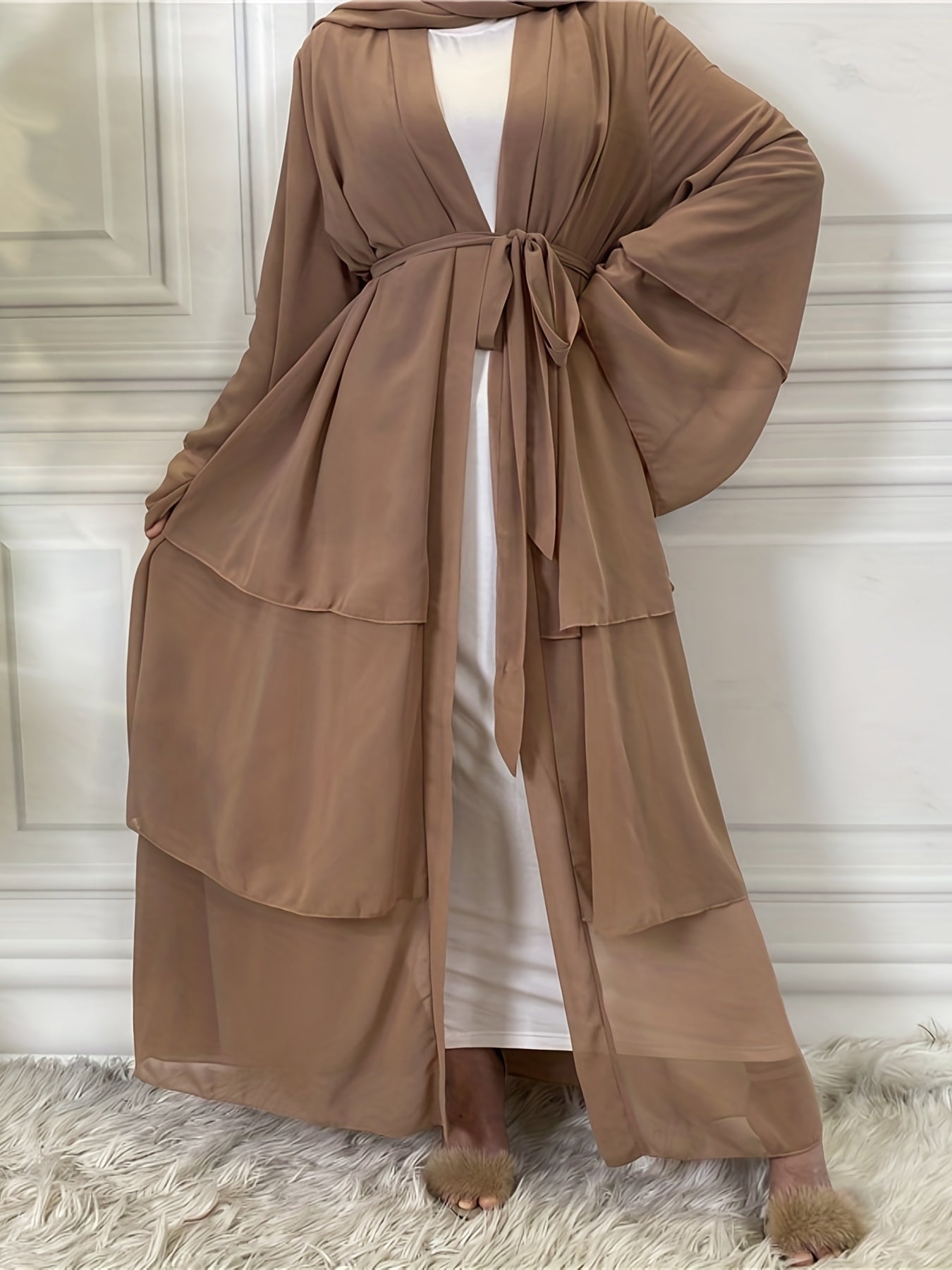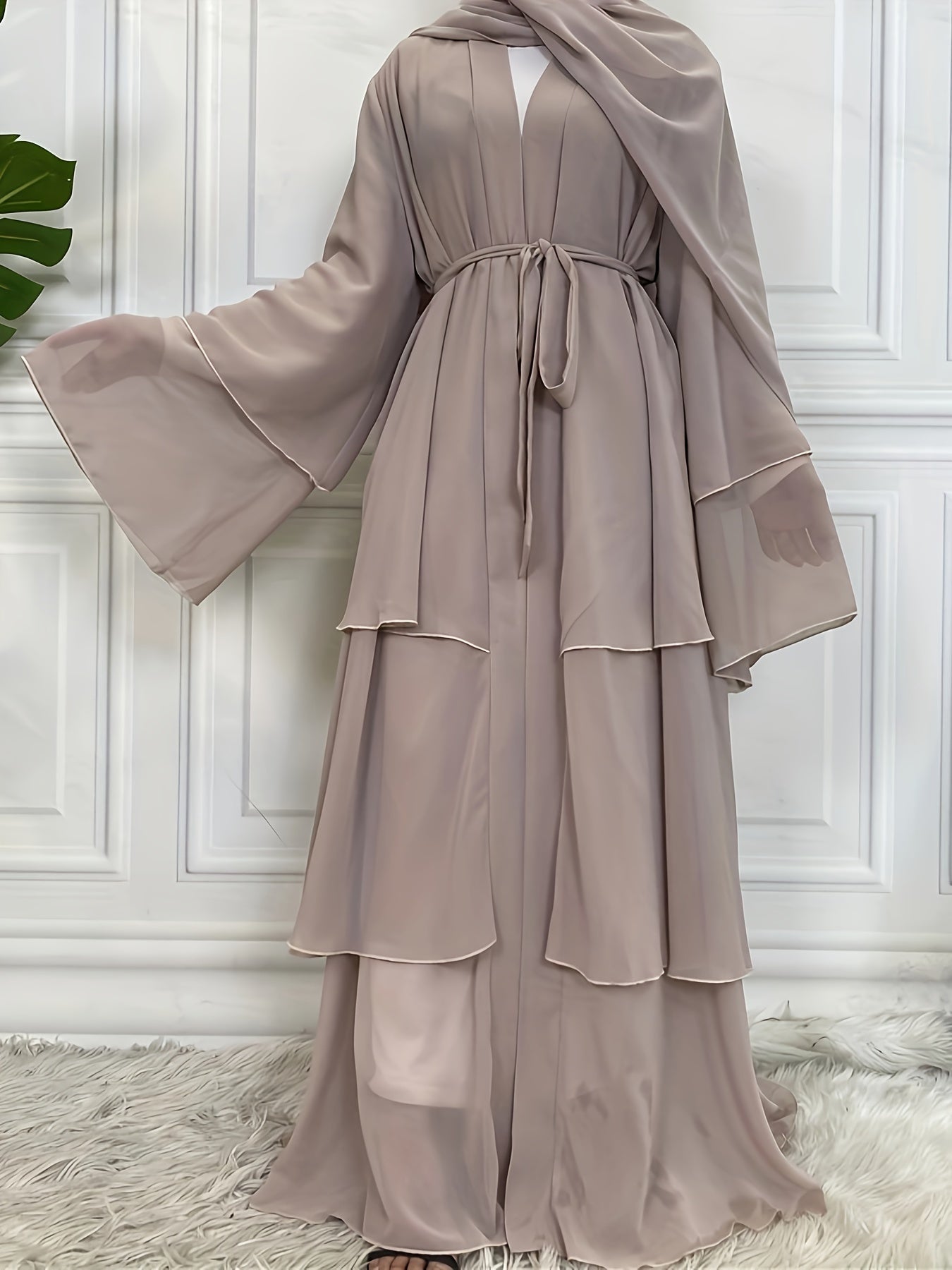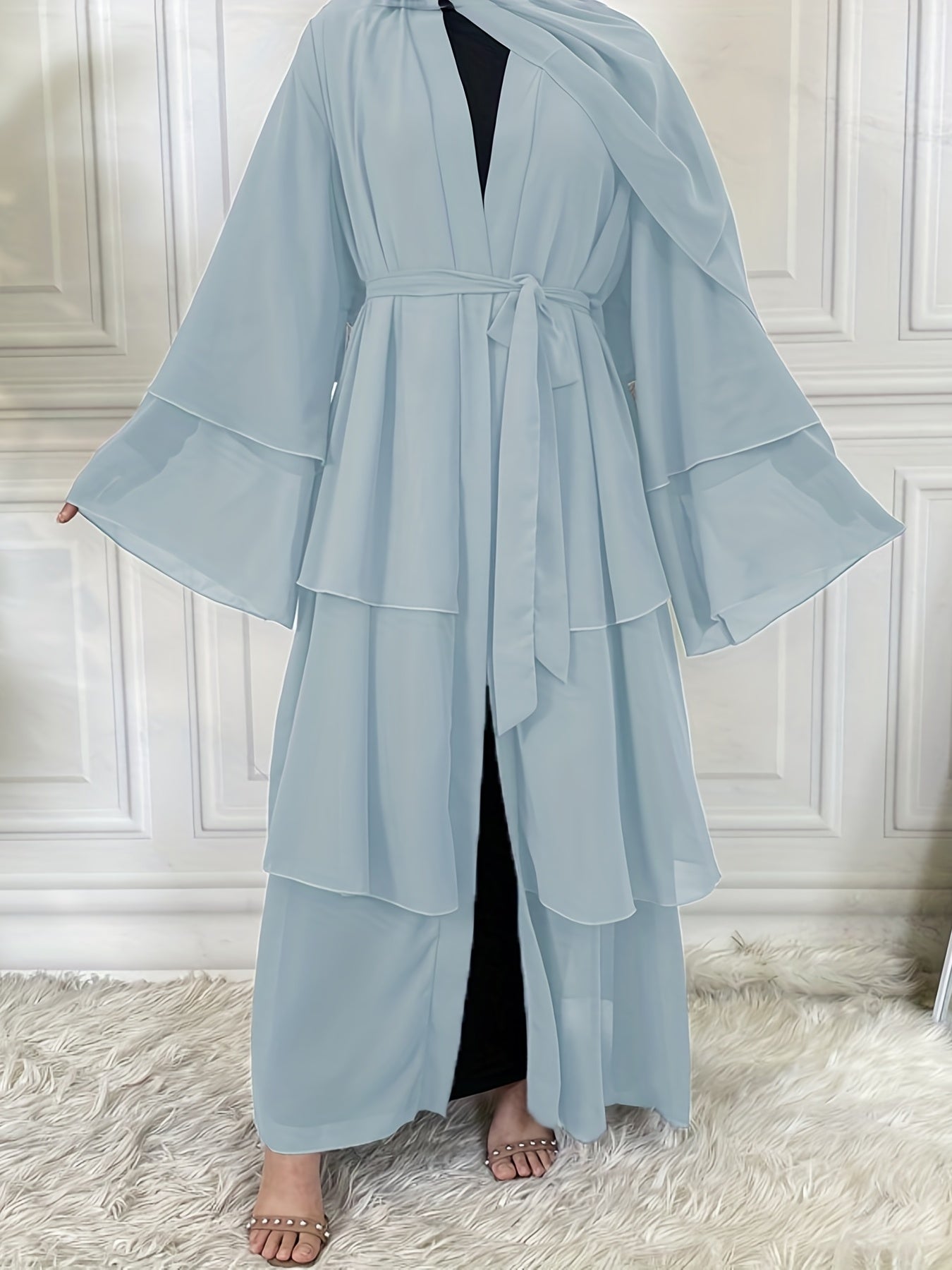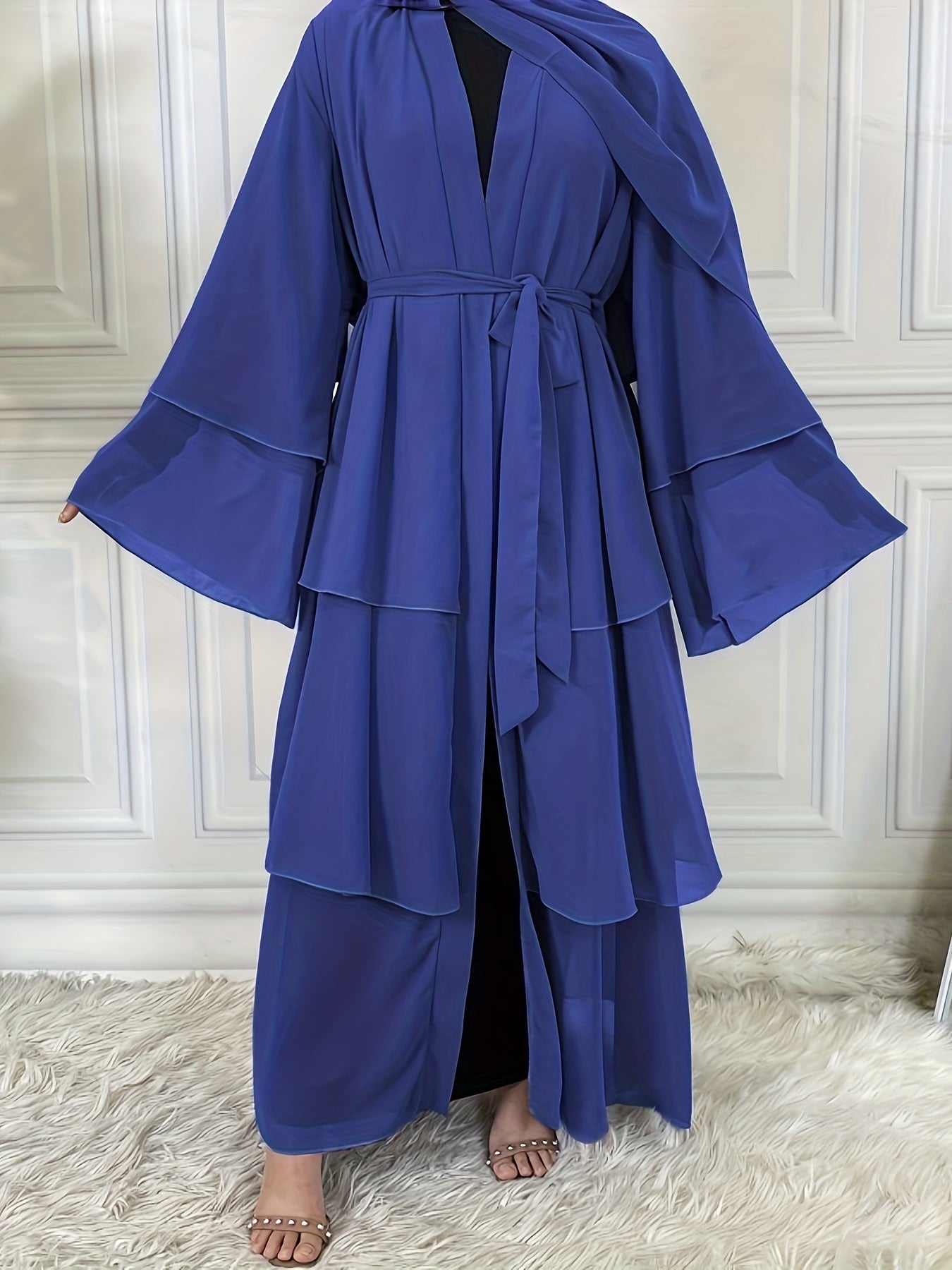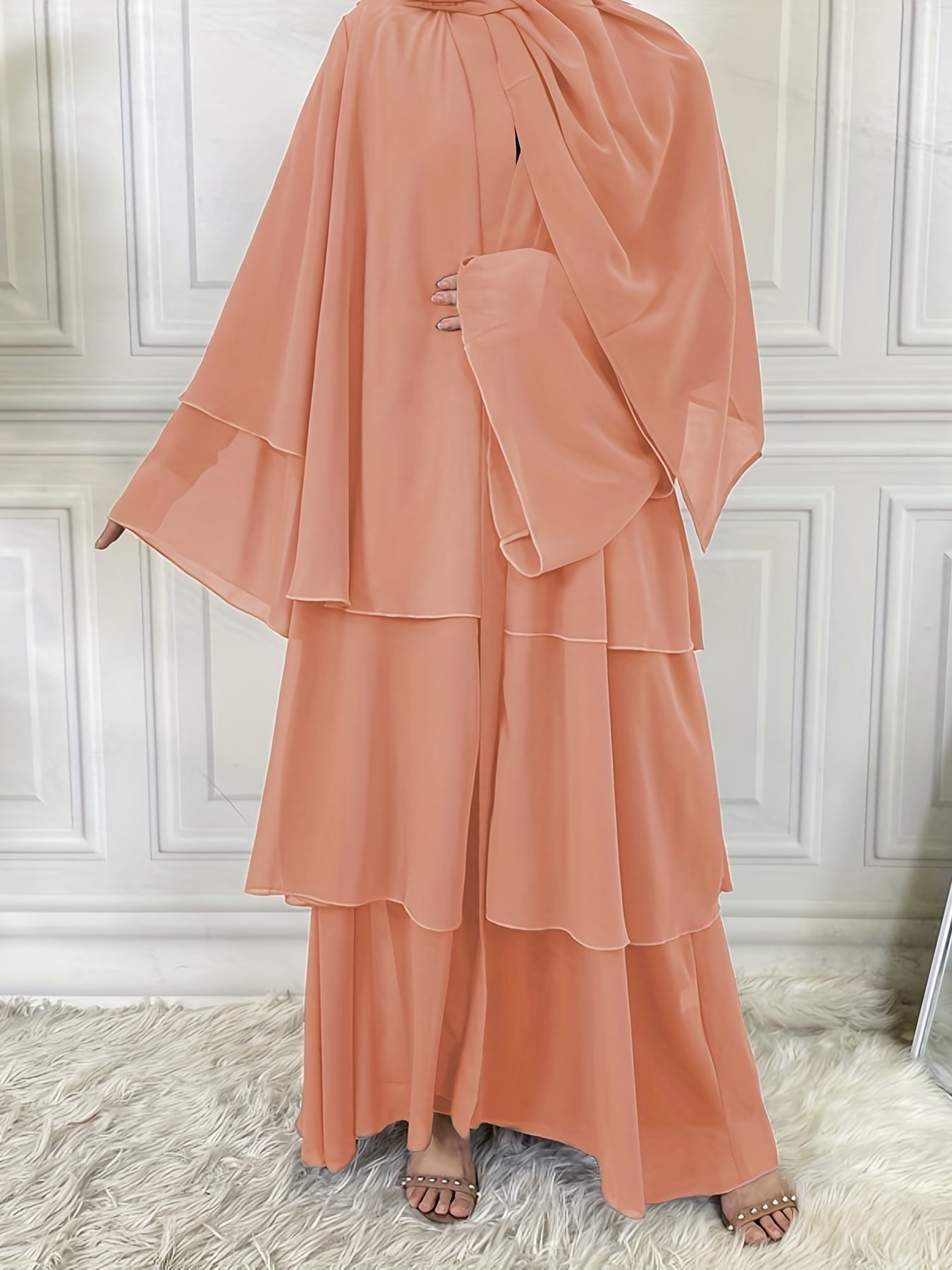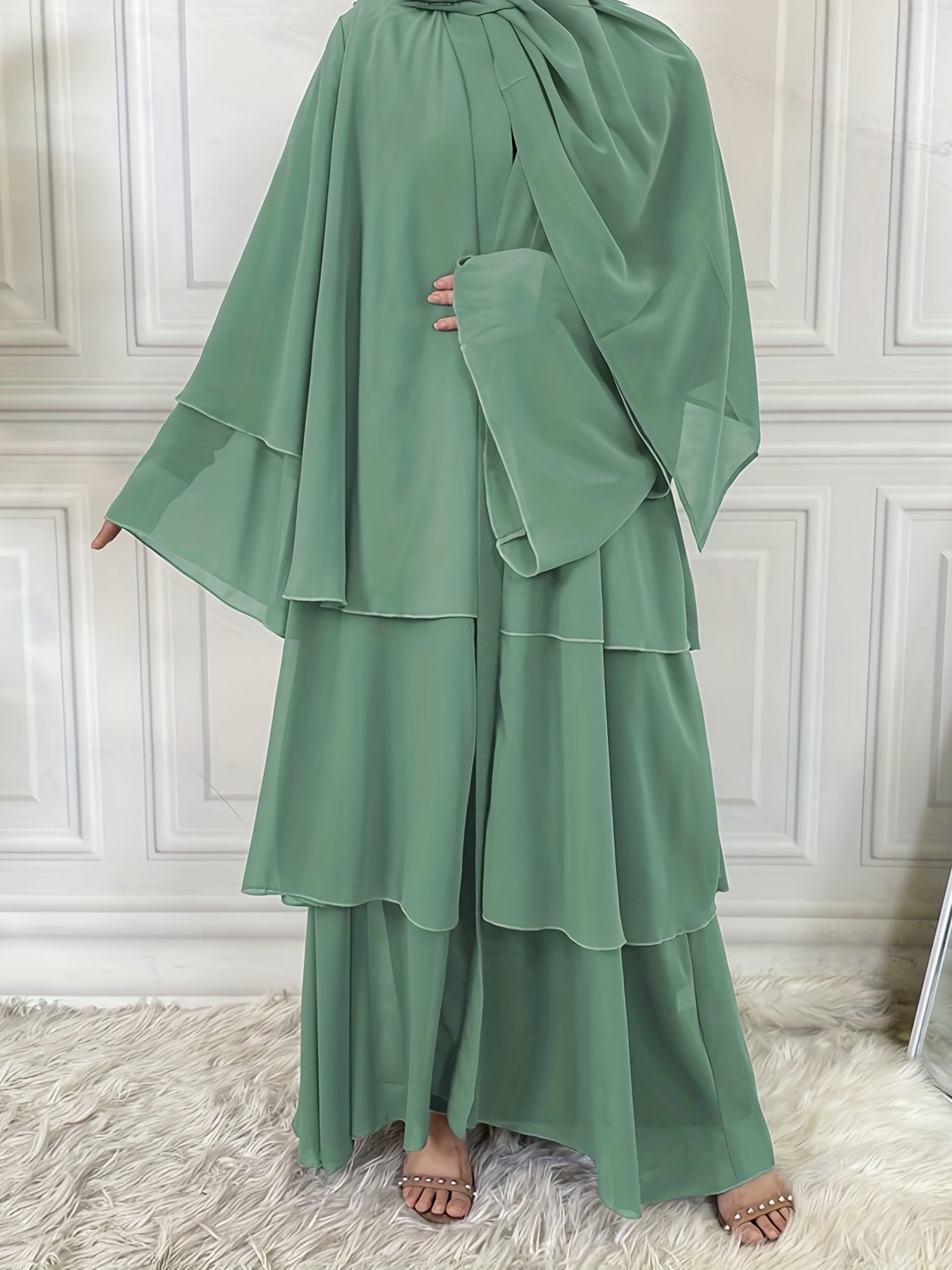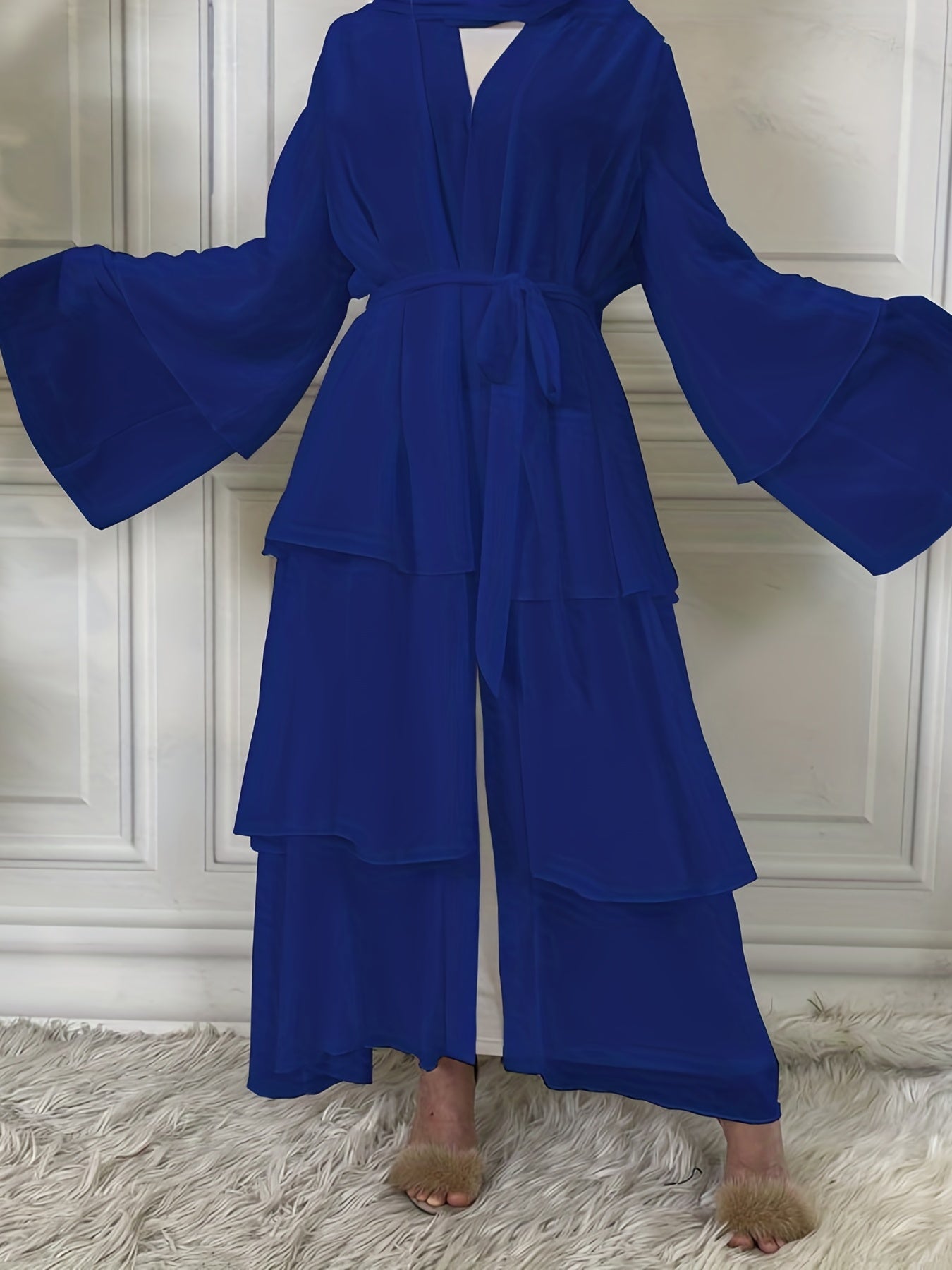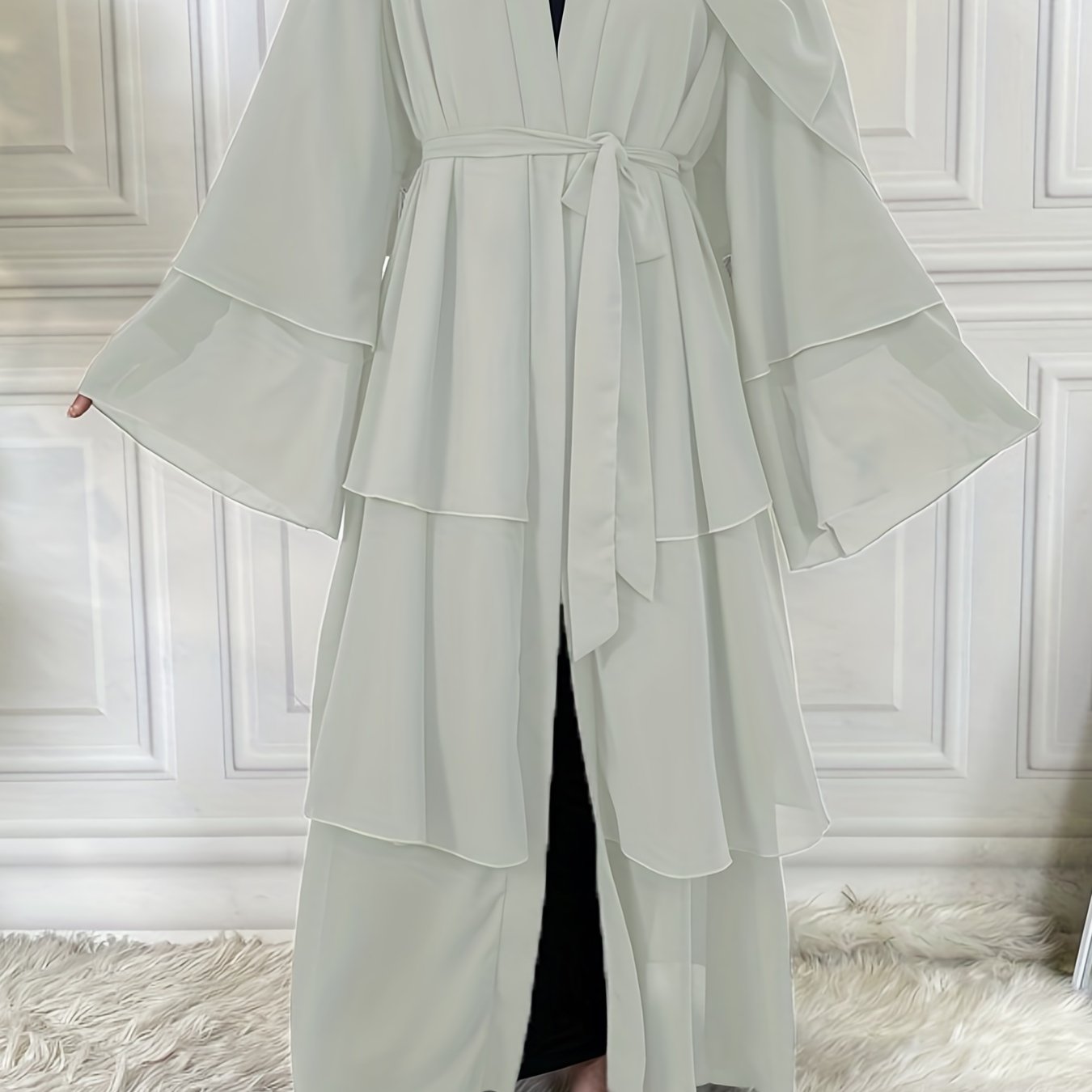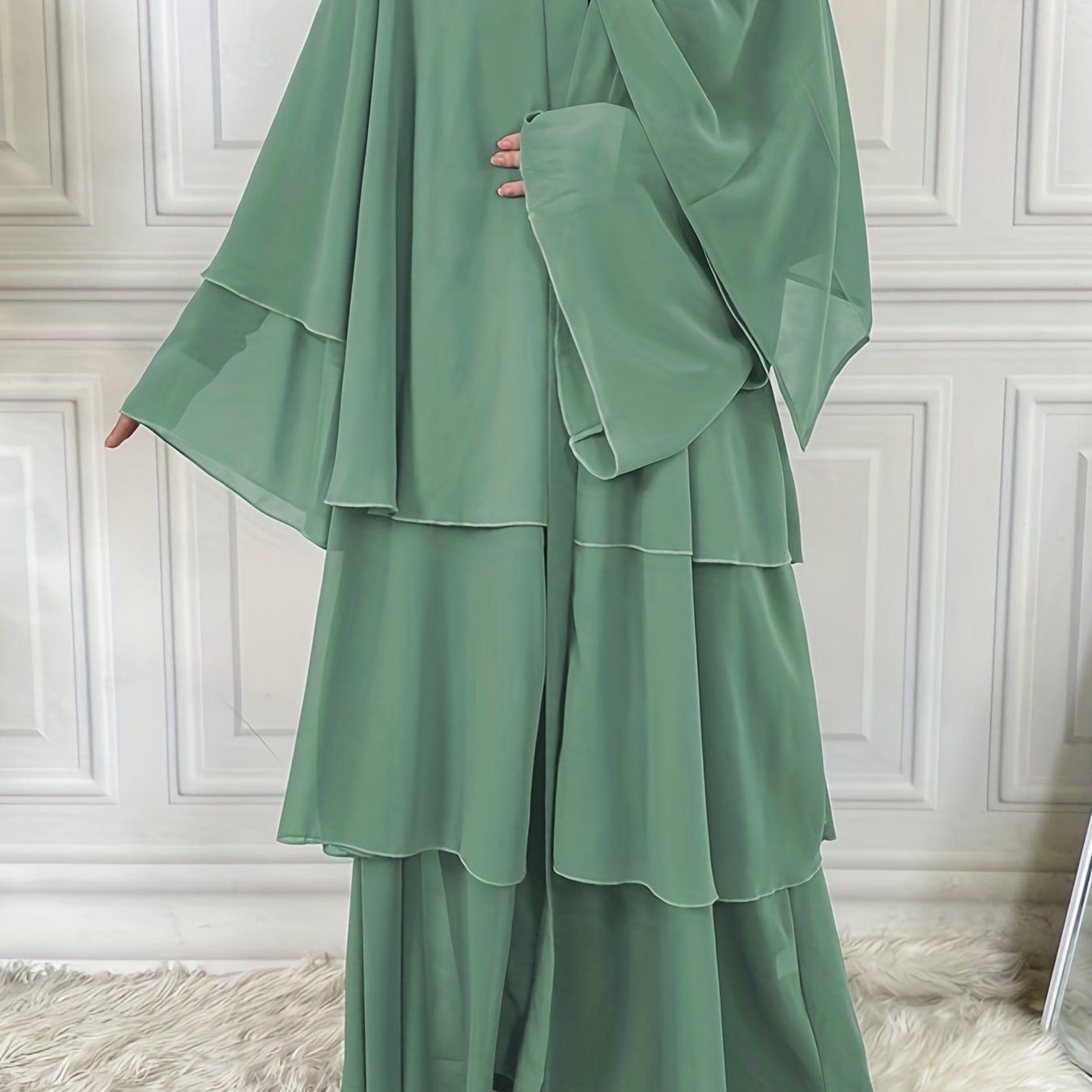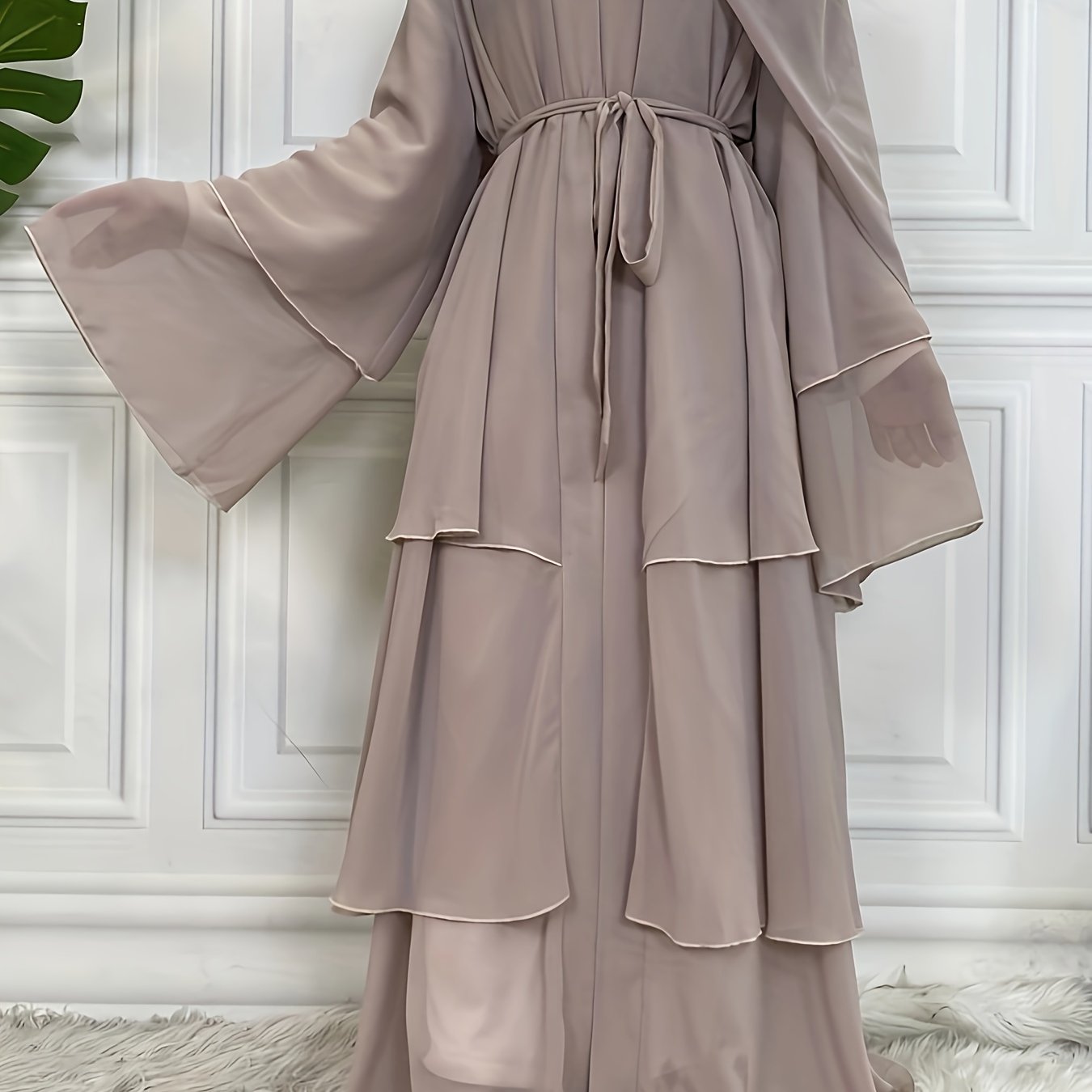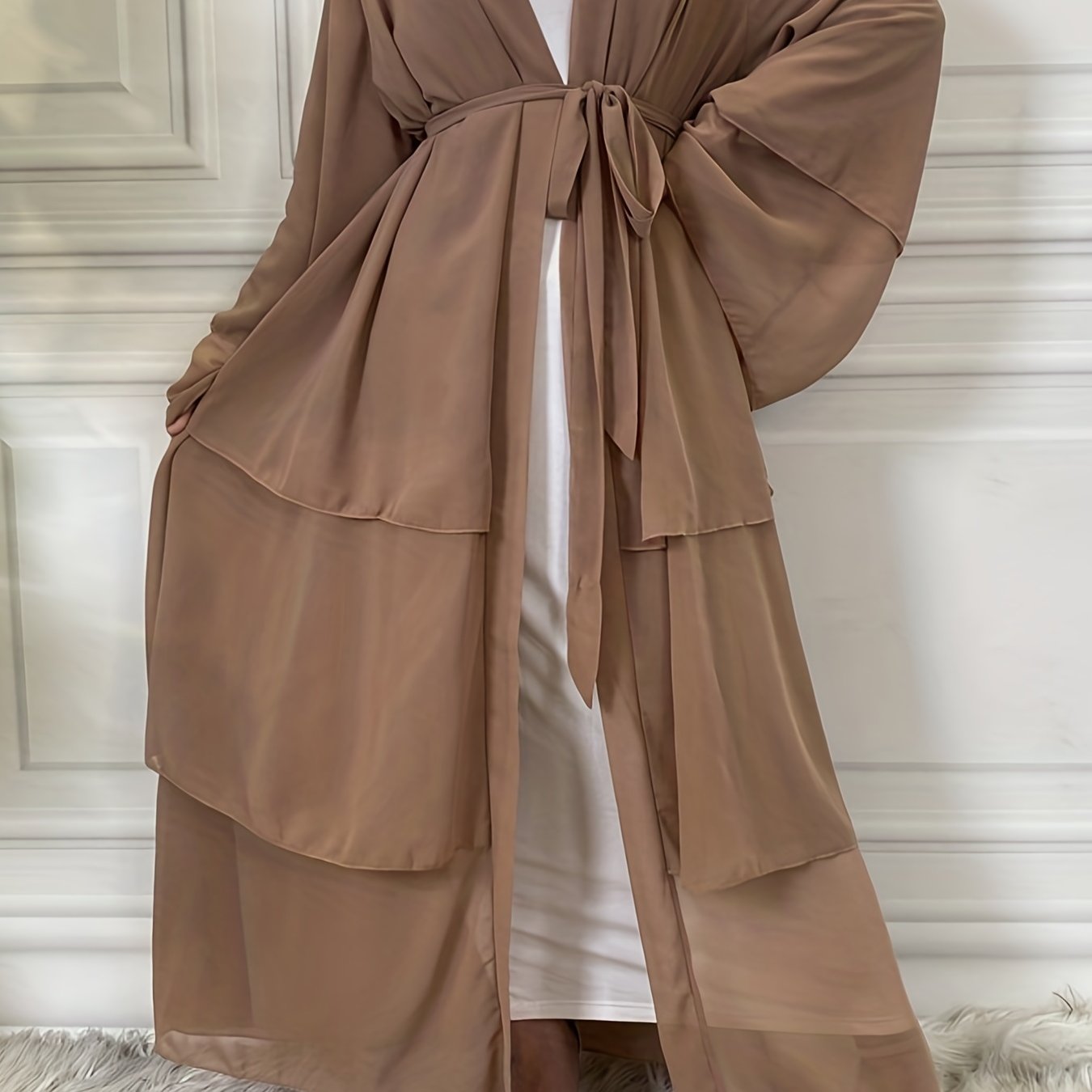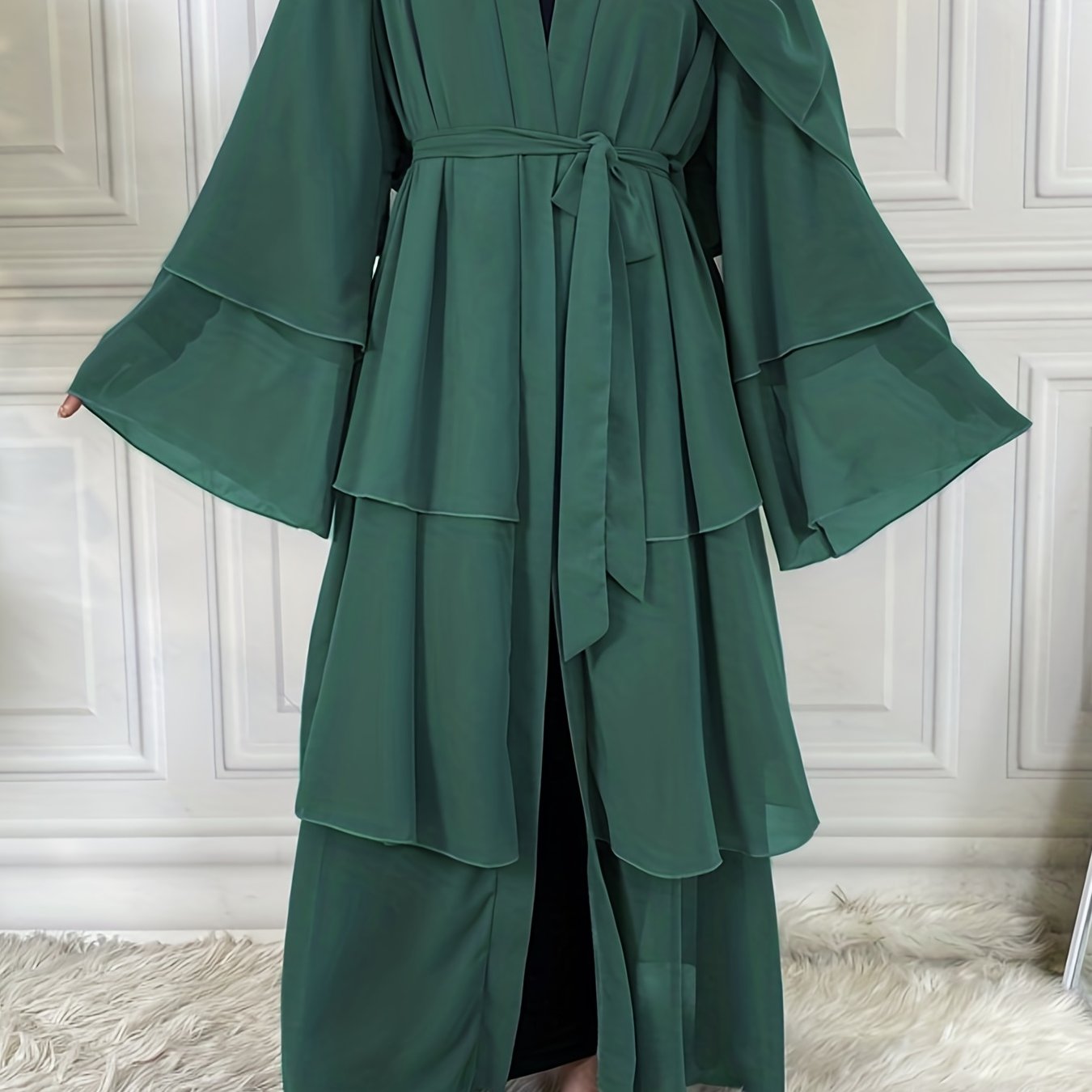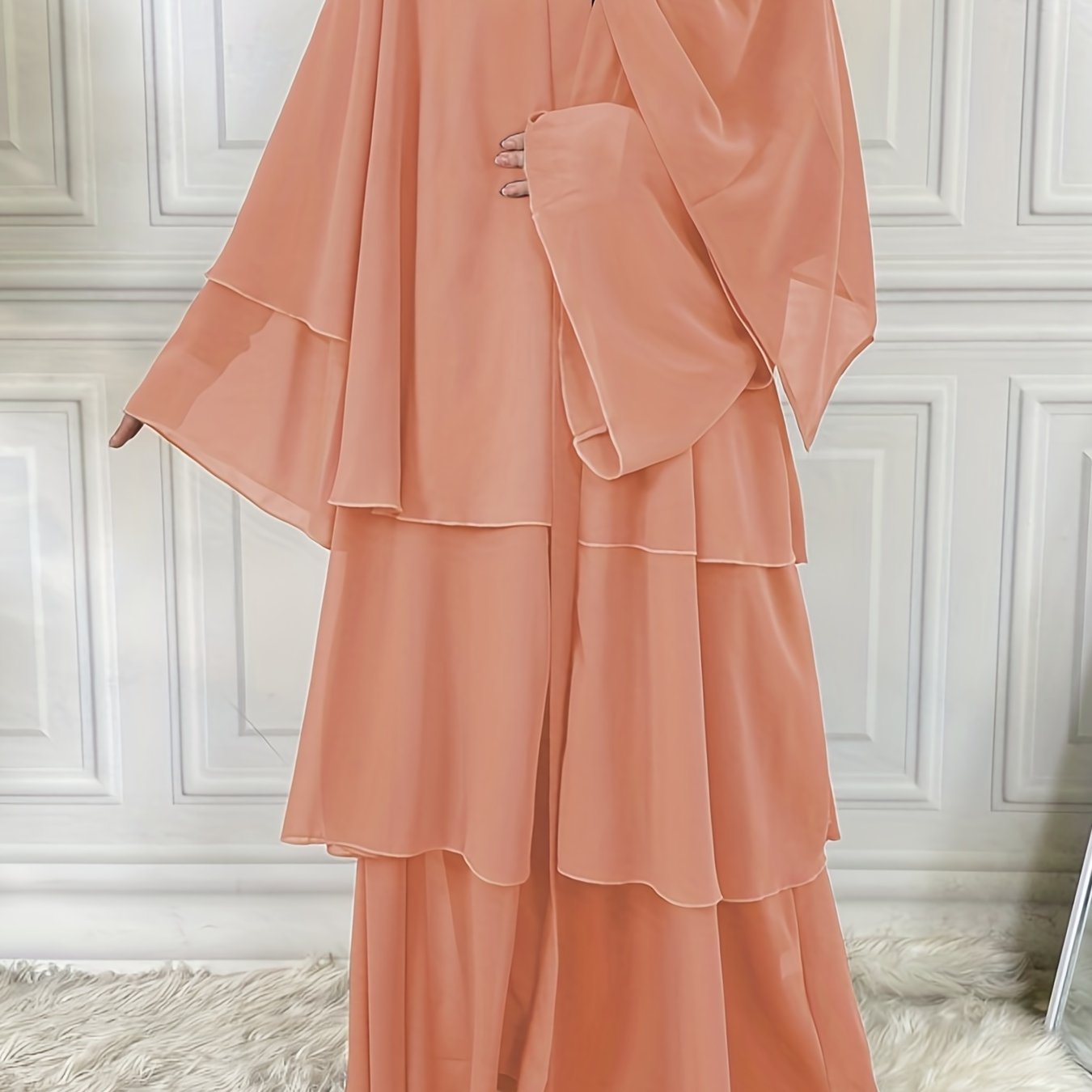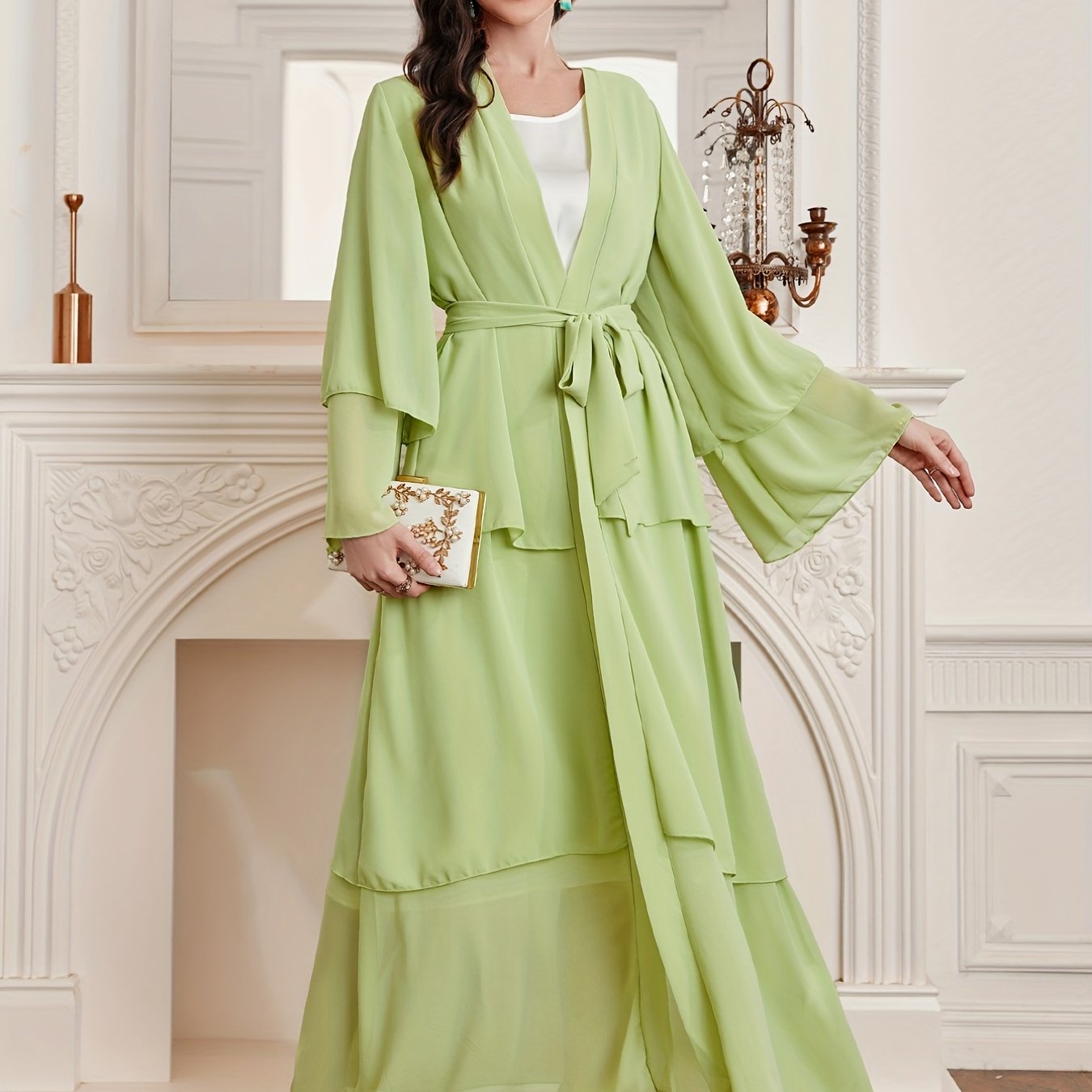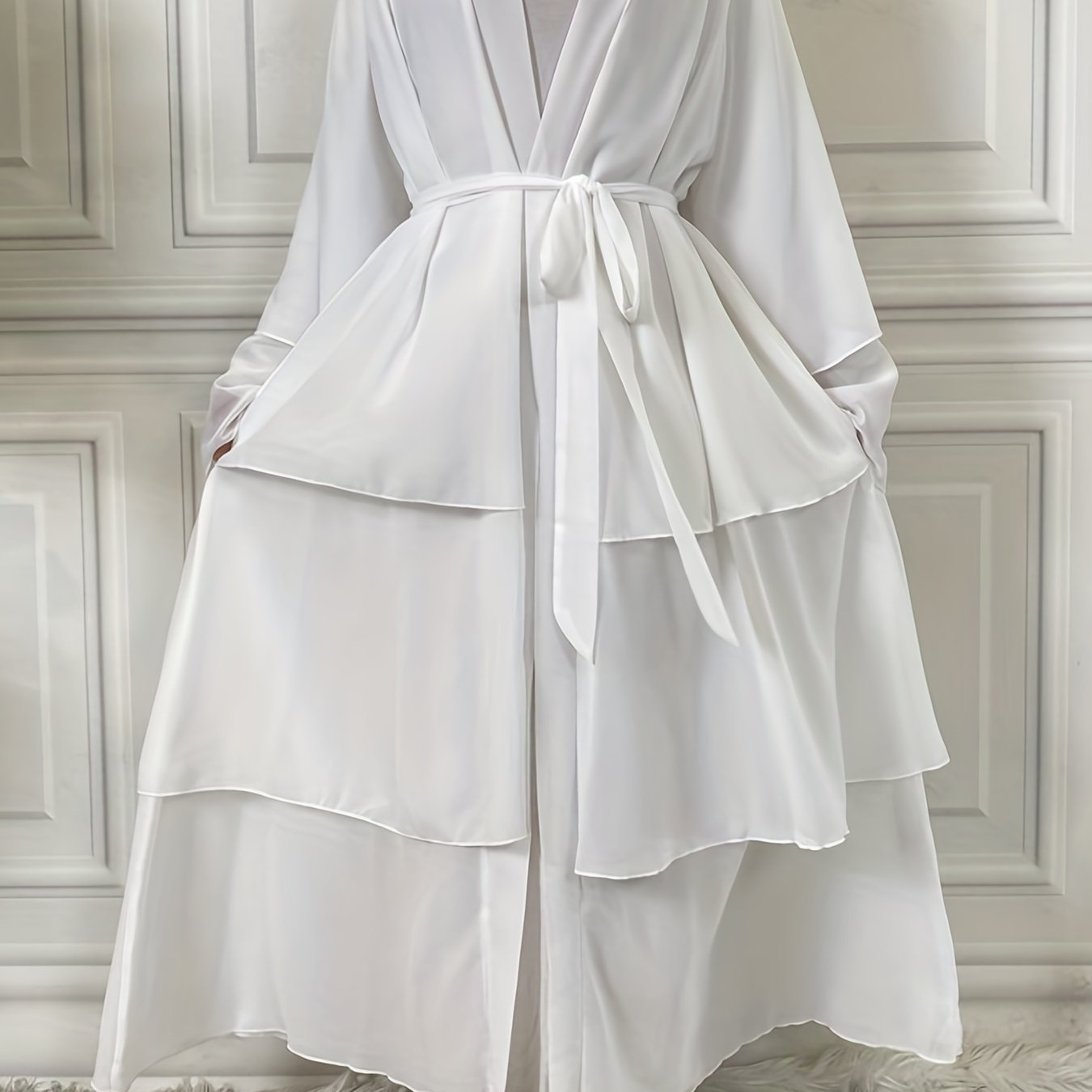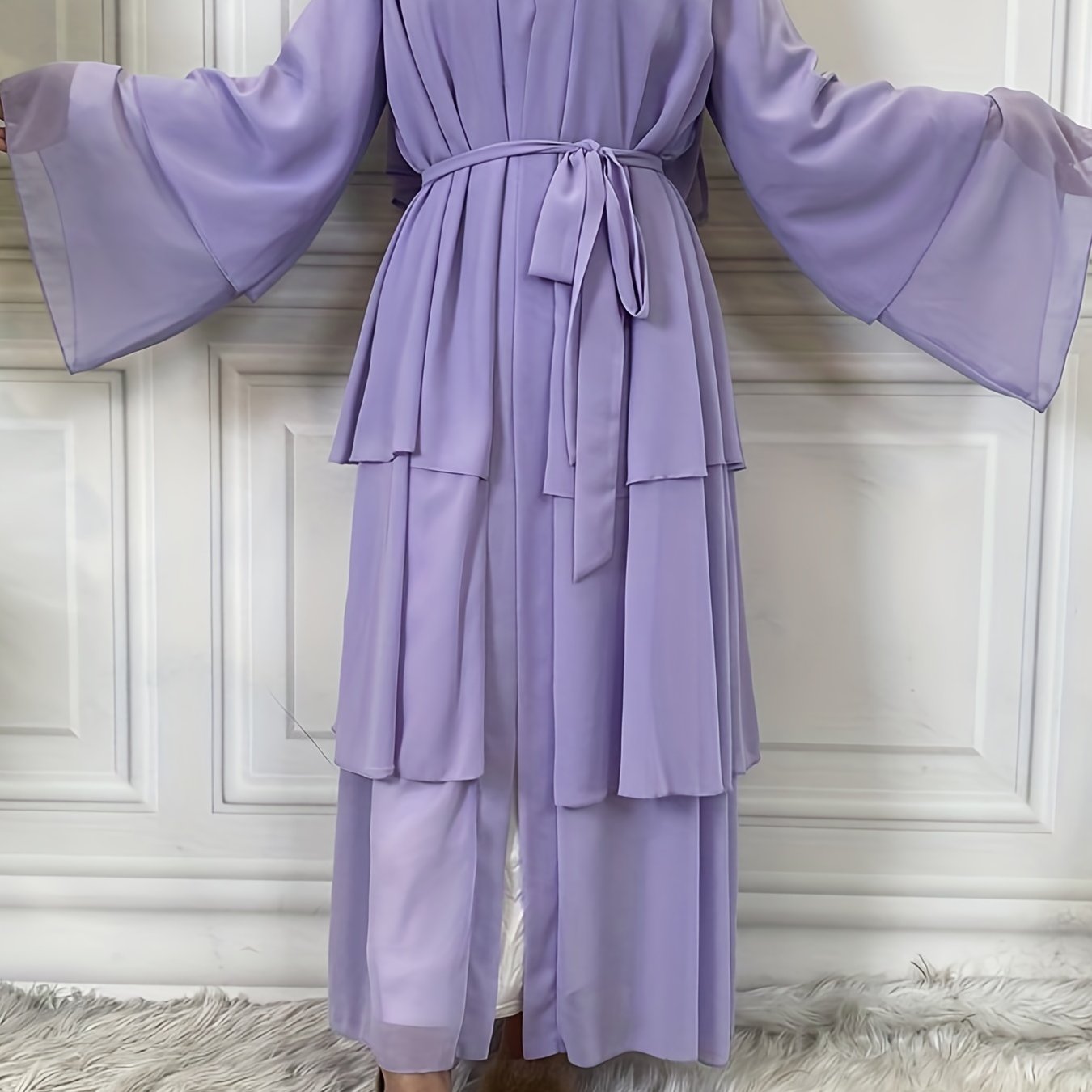SPECIFICATIONS
Composition: 100% Polyester
Details: Belt
Fabric: Non-Stretch
Fabric Elasticity: No Elasticity
Material: Chiffon
Operation Instruction: Hand wash,do not dry clean
Pattern: Solid color
Printing Type: No Printing
Season: Spring/Summer/Fall
Sheer: Semi-Sheer
Weaving Method: Woven
Women’s Modest Pakistani Abaya – Ramadan Layered Open Front Long Sleeve Dress with Belted Style, Without Hijab
The layered open front abaya has always held a place of quiet reverence in the world of modest fashion. This particular Ramadan Layered Open Front Modest Pakistani Abaya, offered in a belted silhouette without hijab, draws attention not through extravagance but through its restraint. Its timeless structure is rooted in cultural legacy yet finished with modern refinement, making it one of the most significant garments in contemporary wardrobes for women who value dignity and grace.
The design speaks to the unique rhythm of Ramadan itself. During this sacred month, attire transcends utility and becomes part of ritual and identity. The abaya in question captures that essence: layered for depth, belted for definition, open-front for fluidity. It is not merely a garment but an emblem of how clothing can represent faith and cultural belonging while remaining adaptable to contemporary settings. By pairing the richness of tradition with an architectural form that feels light and flowing, this abaya becomes the bridge between history and modernity.
Its open-front construction nods to traditional cloaks once used across deserts and bustling marketplaces, garments meant to protect, cover, and symbolize modest living. Today, that same form has been refined into something more structured, where layering does not merely serve function but also creates visual harmony. When worn, it carries an aura of authority and serenity, embodying the quiet strength often associated with women who move effortlessly between personal, spiritual, and social roles.
Design Philosophy: Layering, Fluidity, And Structure
The design of this abaya rests on three elements: layering, fluidity, and structure. Each is a cornerstone of the philosophy behind modern modest attire. The layering is not superficial; it adds dimension and a sense of progression, as though the garment tells a story in tiers. When the wearer walks, the layers shift with subtle motion, creating elegance that is never overstated yet always noticed.
Fluidity defines the open-front silhouette. Unlike fitted garments, this abaya refuses confinement, favoring movement and freedom. Its open construction allows air to circulate, a practical consideration during warm evenings of Ramadan but also a symbolic one, suggesting openness and adaptability. The belted feature introduces structure, balancing the looseness of the garment by drawing the eye to the waist. This contrast between flow and form prevents the abaya from appearing shapeless, instead creating balance that flatters without compromising modesty.
The long sleeves extend the design’s continuity. They elongate the silhouette, making the figure appear statuesque while ensuring complete coverage. The sleeves also contribute to the garment’s quiet power, echoing the lines of historical robes that conveyed authority and presence. Together, these design elements work not in competition but in harmony, producing an attire that is both serene and commanding.
To understand this design philosophy is to appreciate how each element interacts with both body and spirit. Layering in this context is not only physical but metaphorical. It reflects the depth of character, the multiple roles women embody, and the layered experiences of Ramadan itself. The subtle shifts of fabric as the wearer moves are a visual metaphor for adaptability, reminding us that true elegance lies in embracing change with grace.
Fluidity carries its own message. In fashion, garments that allow ease of movement reflect a confidence that does not require rigidity. The abaya’s open-front construction honors that idea, showing that modest attire can be liberating rather than restrictive. It allows women to step into different environments—prayer halls, family gatherings, professional spaces—without altering their essence. The design’s ability to breathe, to flow, and to adapt affirms that modesty is not about limitation but about expansion.
Structure, on the other hand, ensures discipline. The belt is not merely decorative; it acts as a visual anchor, reminding the design that beauty also lies in proportion and balance. Without it, the garment could overwhelm; with it, the abaya achieves refinement. This structure is symbolic of Ramadan itself, where discipline enhances freedom, and intention shapes experience. The abaya, therefore, becomes more than attire—it is an architectural lesson in how balance creates harmony.
What emerges from this philosophy is a garment that unites contrasts: softness with strength, freedom with control, continuity with adaptability. The abaya’s design embodies a duality that feels modern yet timeless, practical yet poetic. Its layered, fluid, and structured form reflects not only the principles of fashion but also the values of life lived with grace and dignity.
Historical Continuity And Cultural Relevance
Tracing the abaya’s history reveals its significance as more than clothing. From the early Arabian cloaks to Ottoman adaptations, from South Asian robes to North African interpretations, garments resembling this layered form have existed across centuries and cultures. Each retained the central principles of modesty and identity, adapting only in textile or detail. The Pakistani iteration emphasizes flowing lines and practical tailoring, suited to climates where coverage must harmonize with comfort.
This Ramadan version continues that continuity. Its design is deeply relevant in modern contexts where modest fashion is no longer confined to specific geographies but has entered international runways and global wardrobes. Wearing such a piece situates the individual within a tradition of faith and heritage while also positioning her within the language of modern elegance. It demonstrates that modest wear is not marginal but central to the evolving narrative of global style.
Culturally, the abaya speaks of devotion, respect, and belonging. During Ramadan, when spirituality and community intersect, wearing garments that echo centuries of tradition strengthens identity. Yet this abaya also recognizes the contemporary woman’s demand for versatility. Its ability to be worn in sacred gatherings, family events, professional spaces, or formal evenings ensures that cultural values are not left behind in pursuit of modern life but woven seamlessly into it.
Symbolism Of The Open Front And Belted Form
Every element of this abaya’s design carries symbolic weight. The open front, for instance, suggests welcome, transparency, and transition. It allows the wearer to layer garments beneath, symbolizing depth of character and individuality. The layers do not obscure but reveal—carefully, deliberately—echoing the way faith reveals inner strength without requiring spectacle.
The belt adds another dimension of meaning. Beyond defining shape, it signifies intentionality. To tie a belt is to gather, to secure, to affirm control. Within the context of Ramadan, this symbolism deepens. The belt can be seen as a metaphor for discipline, the act of drawing oneself inward, focusing intentions, and centering devotion during a sacred month of restraint and reflection. Thus, the abaya becomes both attire and metaphor, holding spiritual symbolism in its physical form.
The long sleeves, likewise, extend beyond coverage into symbolism. Length has always conveyed dignity, from robes worn by ancient leaders to the sweeping garments of scholars and poets. In this abaya, the sleeves remind the wearer that modesty does not restrict but elevates. By extending the lines of the body, they cultivate poise and grace, attributes associated with inner strength and outer dignity.
Contemporary Elegance And Global Influence
In the current fashion landscape, modest attire has gained recognition not only for its cultural significance but also for its aesthetic power. Global designers now incorporate abaya-inspired forms into their collections, adapting open-front layering and flowing lines into gowns and coats. This wider acknowledgment has given garments like this Ramadan Layered Open Front Abaya new resonance, positioning them not as niche but as emblematic of an international dialogue on style and identity.
The Pakistani influence is evident in the cut and finish. Known for blending simplicity with detail, Pakistani design traditions elevate fabric through silhouette rather than embellishment. This abaya follows that ethos. Its understated elegance means it can be worn across borders, from Middle Eastern gatherings to Western events, without appearing out of place. Its layered construction appeals to minimalist sensibilities in Europe as much as it resonates with the heritage-driven wardrobes of South Asia.
This global adaptability enhances its relevance. The woman wearing it can move from one cultural space to another, carrying her values without needing to alter her attire. The garment becomes a passport of modesty, universally understood and appreciated for its refinement.
Emotional Resonance Of Styling Choices
Wearing an abaya is never only about external appearance; it is an emotional act. This particular design, with its layered openness and belted waist, evokes emotions of strength, serenity, and continuity. The wearer experiences not only comfort but also affirmation of identity. To place this garment over one’s shoulders is to step into a tradition, to carry forward a cultural and spiritual lineage while making it one’s own.
Styling choices heighten this resonance. Pairing it with understated jewelry emphasizes elegance without ostentation. Selecting inner garments in soft neutral tones creates layers that are harmonious and contemplative, ideal for Ramadan evenings. Alternatively, choosing bold contrasts beneath the open front allows the abaya to serve as a canvas for individuality. Each choice tells a story, turning the garment into a medium of personal expression within the broader context of modest tradition.
Emotionally, the act of tying the belt can be profound. It gathers not only fabric but intention. For women observing Ramadan, it can become a symbolic ritual in itself: drawing focus, preparing for prayer, or readying oneself for community gatherings. Such small details transform clothing into lived experience, giving garments a role in daily rhythms of faith and identity.
The Palette Of Subtle Elegance
Color is not merely a surface choice in modest fashion; it is a language of its own. The Ramadan Layered Open Front Modest Pakistani Abaya speaks in a palette that is deliberate, refined, and deeply symbolic. Solid hues dominate its canvas, echoing centuries of modest attire that valued restraint over flamboyance. Yet these solid tones are not devoid of depth. Instead, they carry the subtle variations of texture and shadow created by the layered construction, allowing even a single shade to reveal complexity.
Neutral colors like black, beige, and navy have always been staples in abayas, chosen for their universality and adaptability. Black, in particular, remains timeless, not as a limitation but as an elevation of grace. When cast upon this layered open-front silhouette, black transforms into a statement of confidence and authority. Beige and earth tones, on the other hand, soften the garment, emphasizing warmth and approachability. Navy introduces a contemporary twist, drawing on global fashion’s admiration for deep, versatile blues. Each shade interacts with the design differently, shaping the garment’s mood without altering its essence.
Beyond these classics, subtle pastels and muted jewel tones have found their way into modern abaya palettes. Dusty rose suggests softness, while olive or sage green draws inspiration from nature, aligning with Ramadan’s themes of renewal and balance. These colors allow the abaya to function across multiple occasions, from sacred gatherings to social events, adapting effortlessly to context. They also broaden the appeal beyond cultural boundaries, ensuring the wearer feels timeless yet relevant.
Material Science: The Fabric Of Comfort And Strength
The choice of fabric determines not only the aesthetic but also the experience of wearing this abaya. Crafted from lightweight yet resilient textiles, the Ramadan Layered Open Front Modest Pakistani Abaya demonstrates the evolution of modest wear into garments that balance luxury with practicality. Traditional fabrics like cotton and silk once defined abayas, offering breathability and elegance but often requiring meticulous care. Contemporary interpretations rely on innovative blends that combine the softness of natural fibers with the durability of synthetics.
Polyester blends, for example, are celebrated for their ability to hold color, resist wrinkles, and maintain shape. In layered garments like this, such fabrics ensure that the silhouette retains its intended form even after prolonged wear. They also reduce the burden of maintenance, aligning with the lifestyle of modern women who require garments that are both elegant and practical. Rayon and chiffon blends introduce lightness and translucence, creating graceful movement with each step. Their drape enhances the open-front construction, emphasizing the garment’s fluidity without sacrificing coverage.
Breathability is crucial, particularly during Ramadan when long hours of wear span from day into evening gatherings. Fabrics that allow air circulation prevent discomfort while still preserving the garment’s dignified structure. This balance of softness and resilience reflects a broader trend in modest fashion: prioritizing not just how a garment looks but how it feels in motion. By using materials that combine comfort with strength, the abaya becomes a garment that supports rather than hinders daily life.
Functionality In Everyday Life
An abaya is more than an expression of modesty; it must serve the practical needs of its wearer. The Ramadan Layered Open Front Abaya demonstrates functionality through design details carefully integrated into its silhouette. The open front allows for effortless layering, making it adaptable across climates and personal styles. Whether worn over lightweight inner dresses in summer or layered over warmer fabrics during cooler months, its construction ensures year-round usability.
The belted waist offers both functionality and flexibility. It allows the wearer to adjust fit according to preference, either cinching for a more defined look or leaving loose for maximum comfort. This adaptability acknowledges the diversity of women’s bodies and the reality that comfort levels change with setting, time of day, and personal mood. The belt also functions as a design anchor, ensuring the garment retains structure even when layered with multiple pieces beneath.
Long sleeves provide another dimension of practicality. Beyond maintaining modest coverage, they shield from sunlight during outdoor activities and offer comfort in air-conditioned indoor spaces. Their full length eliminates the need for additional layering, making the garment self-sufficient. This efficiency is particularly valuable during Ramadan, when daily routines demand garments that transition seamlessly between prayer, work, family gatherings, and social events.
Pockets, when incorporated discreetly, add yet another layer of functionality. They allow women to carry small essentials without needing a bag, reinforcing the abaya’s role as both attire and tool. The open-front design further supports movement, ensuring ease of walking and sitting, whether in domestic or formal spaces. Each of these functional choices underscores a design philosophy that values practicality without diminishing elegance.
The Versatility Of Layered Construction
Layering is not simply aesthetic; it is a strategy of versatility. In this abaya, the layered open-front construction allows the wearer to reinterpret the garment daily. By pairing with different underlayers—whether monochromatic dresses, contrasting colors, or patterned fabrics—the same abaya transforms into multiple looks. This versatility is especially important during Ramadan, when wardrobes must support both spiritual gatherings and celebratory iftar dinners.
The layers also create dimension. Unlike flat garments that rely on embellishment for impact, layered abayas achieve presence through architecture. Each fold and overlap becomes part of the garment’s dialogue with movement and light. This ensures the abaya retains elegance in both minimal and adorned contexts, requiring little more than thoughtful styling to suit diverse occasions.
Versatility extends to accessories. The abaya’s simplicity allows it to serve as a backdrop for jewelry, handbags, or scarves, each altering the garment’s tone without undermining its modest integrity. By functioning as a canvas rather than a finished picture, the abaya empowers the wearer to define her own style narrative. This adaptability is what transforms the garment from seasonal purchase into long-term investment.
Seasonal Adaptability And Practical Luxury
Another dimension of functionality lies in seasonal adaptability. The fabric blends and open-front design ensure comfort in varying climates, a crucial quality for women in regions where weather can shift dramatically between day and night. During warmer months, the lightweight construction prevents overheating, while the belted waist allows for looser wear that encourages airflow. In cooler seasons, the layered form becomes a natural insulator when paired with thicker undergarments, ensuring warmth without bulk.
This adaptability embodies practical luxury. True luxury lies not only in aesthetics but in ease—the ability to move through life’s demands without complication. A garment that can serve across seasons, adapt to different occasions, and require minimal maintenance demonstrates that luxury and practicality are not opposing forces but partners in design. This abaya represents that union, where elegance serves daily life rather than existing apart from it.
Emotional Comfort And Confidence
Beyond practical function, the abaya offers emotional functionality. It provides a sense of assurance, allowing the wearer to step into diverse spaces with confidence that her attire aligns with her values. During Ramadan, when the balance between devotion, family, and community becomes central, such confidence is invaluable. Clothing that requires constant adjustment or induces discomfort distracts from the experiences that matter most. This abaya, with its thoughtful construction, supports rather than detracts, enabling focus on faith, relationships, and celebration.
The belted design also contributes to emotional comfort. The ability to choose fit and form empowers the wearer, reinforcing autonomy within modesty. Each adjustment of the belt or layering of colors beneath becomes an act of self-expression, affirming individuality while remaining rooted in tradition. This intersection of personal choice and cultural continuity illustrates how functionality extends beyond the physical into the psychological, making garments like this indispensable companions during sacred and social moments alike.
Cultural Significance Across Generations
The abaya has never been a fleeting garment. It has lived through centuries of adaptation, migration, and reinterpretation, becoming more than fabric stitched into a robe—it is memory woven into attire. The Ramadan Layered Open Front Modest Pakistani Abaya reflects this ongoing legacy. To wear it is to engage in a dialogue with history, acknowledging generations of women who embraced similar forms for dignity, faith, and identity. Its open front and layered architecture echo earlier garments that were crafted to shield against climate, yet also to affirm modesty as a visible expression of inner conviction.
In South Asia, layered robes have long played a role in ceremonies, gatherings, and everyday life. Their flowing silhouettes symbolized continuity, extending family traditions across generations. This abaya continues that symbolism, designed to be worn during Ramadan, a time when reflection on heritage and continuity is especially poignant. The belt, when tied at the waist, becomes more than a stylistic choice. It is a ritual of gathering oneself, not only physically but spiritually. By blending historic echoes with modern detailing, this abaya connects women of today with their predecessors in an unbroken cultural thread.
The garment’s ability to preserve heritage while speaking fluently to contemporary aesthetics ensures it remains a living cultural emblem rather than a relic. Its relevance is not diminished by time; instead, it grows richer as it absorbs layers of meaning from each generation that adopts it.
The Abaya In Global Modest Fashion
Modest fashion has undergone a remarkable transformation in the global landscape. Once viewed as niche or culturally specific, it has now been embraced by international fashion houses and mainstream consumers alike. Within this shift, garments like the Ramadan Layered Open Front Modest Pakistani Abaya stand as symbols of how tradition informs global aesthetics.
The open front silhouette resonates with international trends favoring layering and fluidity. Global runways have embraced capes, draped coats, and flowing maxi dresses, yet the abaya’s design predates and surpasses these fleeting trends. This positions the abaya not as an adaptation to global fashion but as a precursor to it—a garment that demonstrates how modest design principles can inspire worldwide styles.
In Western contexts, women wear abaya-inspired garments at formal events, weddings, and cultural festivals. In the Middle East, the abaya remains central to daily wardrobes, embodying values of modesty and elegance. South Asian interpretations blend traditional textile artistry with abaya silhouettes, producing garments that balance simplicity with ornate detailing. Each region shapes the garment in its image, yet the core philosophy—coverage with elegance—remains constant. This global adaptability ensures that the abaya does not merely survive in a fashion system dominated by rapid cycles; it thrives, offering stability and continuity.
Ramadan As A Context For Style And Spirit
Ramadan provides a backdrop against which this abaya’s significance is magnified. It is not just a month of fasting but a season of reflection, devotion, and community. Clothing during Ramadan becomes part of the spiritual environment. It must be comfortable enough for prayer, dignified enough for gatherings, and elegant enough to embody the celebratory spirit of iftar and Eid. The Ramadan Layered Open Front Abaya fulfills all these requirements effortlessly.
Its open front design allows women to transition between sacred and social spaces without changing garments. The belt permits quick adjustments, accommodating the body through the natural fluctuations of long fasting days. The layered construction adds depth, echoing the layered experiences of Ramadan itself—fasting, prayer, family, community, and renewal. By aligning with the rhythm of the holy month, the abaya becomes more than attire; it becomes an instrument of spiritual and social harmony.
The colors chosen for Ramadan abayas also reflect the duality of the season. Deep, grounding tones echo the solemnity of reflection, while softer or lighter hues celebrate the joy of togetherness. When combined with the layered structure, these colors shift effortlessly from day to night, from mosque to gathering hall, offering continuity for the wearer in every environment.
A Modern Expression Of Modesty
In a fashion world often defined by bold exposure, modest attire asserts an alternative vision of beauty. The Ramadan Layered Open Front Abaya embodies this philosophy by rejecting the notion that elegance requires revealing. Instead, it demonstrates that grace is amplified by restraint. This perspective is increasingly embraced by women who may not identify culturally with the abaya’s origins but who admire its design philosophy.
The open-front silhouette, when layered over contrasting dresses or tailored trousers, can be adapted to metropolitan wardrobes in London, Paris, or New York. The belted waist introduces a structured element familiar to global luxury consumers. The flowing sleeves and elongated lines echo the haute couture gowns that sweep red carpets, yet they remain rooted in modest principles. This balance positions the abaya as a garment that unites tradition and trend, offering women across the world a way to embody modesty without compromising modernity.
Fabulive’s role in presenting this abaya is also part of this modern narrative. By framing the garment not simply as a cultural necessity but as a piece of luxury fashion, the brand elevates modest attire to equal standing with global designer wear. It becomes part of a broader conversation about inclusivity, showing that modesty is not confined to one culture or community but is an option for all women seeking refinement and dignity in their clothing.
Emotional Depth In Cross-Cultural Adoption
When garments cross borders, they acquire new meanings. The abaya, once associated only with specific regions, is now embraced by women from diverse backgrounds. This cross-cultural adoption speaks to the garment’s universal resonance. Its flowing lines communicate serenity. Its coverage conveys dignity. Its adaptability reflects inclusivity. These values are not exclusive to one culture but are shared aspirations across humanity.
For some women, wearing this abaya during Ramadan becomes an expression of faith and tradition. For others, it becomes a way to participate in the season’s sense of community and celebration. In fashion-forward contexts, it may serve as a statement of alternative elegance, resisting fast fashion’s impermanence by embodying timeless design. In each scenario, the abaya holds emotional depth, offering not only comfort to the body but meaning to the spirit.
The belt, when tied, becomes a personal gesture—whether it symbolizes focus during prayer, elegance at a gathering, or empowerment in professional spaces. The open front allows for personal styling, inviting individuality into a garment rooted in collective tradition. This combination of personal freedom and cultural continuity explains why the abaya resonates so strongly across generations and geographies.
Identity, Belonging, And Representation
The abaya functions as more than attire; it is a form of representation. For many women, it affirms identity in spaces where modest fashion is underrepresented. It signals belonging to a tradition that values grace and restraint. Yet it also adapts to contemporary expectations, proving that identity need not be confined by stereotype.
In professional settings, the abaya communicates authority while preserving modesty. In social gatherings, it projects elegance without requiring embellishment. In sacred spaces, it aligns with devotional values. This multifunctionality ensures that women need not choose between representation and adaptability. The abaya allows them to move fluidly across contexts, carrying their identity with them rather than setting it aside.
This ability to serve as both cultural representation and personal expression places the abaya at the heart of modern modest fashion. It is a garment that does not impose but empowers, inviting women to define modesty on their own terms while connecting them to a broader heritage.
Styling The Abaya For Modern Elegance
The Ramadan Layered Open Front Modest Pakistani Abaya is more than a garment of faith and tradition; it is also an adaptable piece that encourages creativity in styling. The open-front design makes it one of the most versatile silhouettes in the modern modest wardrobe. Unlike a closed abaya that defines its form entirely, this open style serves as a frame for the clothing layered beneath, offering endless possibilities for reinvention.
Styling it begins with underlayers. A monochrome inner dress allows the abaya’s layered construction to take center stage, exuding quiet sophistication. For women seeking contrast, a brightly colored or patterned underdress introduces depth, transforming the garment into a statement of individuality while maintaining its modest foundation. Even simple pairings with tailored trousers and a long blouse create an urban aesthetic, ideal for professional environments where authority and refinement must coexist.
Accessories elevate the ensemble further. Slim belts in metallic finishes can be substituted for the fabric belt to add a subtle touch of luxury. Jewelry should be chosen with restraint, complementing rather than overpowering the abaya’s clean lines. A pair of pearl earrings or a minimal gold chain can transform the look for evening gatherings. Footwear adds another layer of expression: flat sandals for casual ease, pointed flats for professional precision, or heeled mules for refined evenings. Each choice reinterprets the garment without compromising its modest integrity.
Hijabs, though not included with this abaya, remain central to styling for many women. Solid chiffon hijabs in complementary shades maintain continuity, while silk or satin scarves in bolder colors create a striking juxtaposition. In either case, the abaya serves as a canvas, allowing accessories and fabrics to write their own stories upon its layers.
From Day To Night: Versatility In Practice
The strength of this abaya lies in its ability to adapt fluidly across times of day and social contexts. During daylight hours in Ramadan, it can be styled simply with neutral layers, minimal accessories, and functional flats, making it suitable for prayer, errands, or professional engagements. As evening arrives and the rhythm of iftar and community gatherings begins, the same garment can be transformed with richer inner tones, statement accessories, and elegant footwear.
This adaptability is vital during Ramadan, when days are long and transitions between personal, spiritual, and social roles are constant. The abaya eliminates the need for wardrobe changes, offering continuity throughout the day. It embodies a philosophy of practical elegance: garments that serve the wearer rather than demanding unnecessary effort. This ability to travel seamlessly from sacred to celebratory environments positions the abaya not only as attire but as a partner in daily life.
Its versatility also extends beyond Ramadan. In professional settings, it communicates authority when paired with tailored underlayers and structured handbags. For travel, it provides comfort and dignity, ensuring the wearer remains refined despite the fatigue of long journeys. At weddings or festive occasions, it transforms into a gown-like statement piece with the right accessories. This fluid adaptability is why such garments endure; they align with the multiple dimensions of a woman’s life.
Maintenance: Preserving Grace And Longevity
Luxury is measured not only in appearance but in durability. A garment that loses shape, color, or texture after minimal wear cannot be considered truly luxurious. The Ramadan Layered Open Front Modest Pakistani Abaya asserts its value through ease of maintenance, ensuring that its elegance remains intact over years rather than months.
The fabric blends used in its construction are designed to resist wrinkling, fading, and shrinking. This makes the abaya resilient enough for frequent wear, particularly during Ramadan when it may be worn daily for prayer and gatherings. Gentle machine washing or hand washing in cold water with mild detergent is typically sufficient. Hand washing, in particular, preserves the softness of the fabric while maintaining the depth of its colors.
Drying should be conducted away from direct sunlight, which can dull hues over time. Instead, natural air drying in shaded areas ensures the garment retains its vibrancy. Ironing, if required, should be performed on low to medium heat, though many modern fabric blends minimize creasing naturally. Storing the abaya on padded hangers helps preserve its shape, particularly around the shoulders where fabric can stretch under weight.
For women who travel frequently, maintenance is simplified by the garment’s wrinkle-resistant nature. It packs easily, requires minimal touch-up, and can be worn directly upon arrival, making it an indispensable companion for journeys during Ramadan or beyond. This balance of elegance and practicality confirms the garment’s status as luxury attire that respects the pace of modern life.
Sustainability And The Ethics Of Modest Fashion
In a fashion industry often criticized for disposability, the abaya represents a philosophy of longevity. The Ramadan Layered Open Front Modest Pakistani Abaya resists fast-fashion cycles by virtue of its timeless design. Where trends rise and fall with seasons, this garment remains relevant year after year, aligning with sustainable consumption practices that prioritize durability over novelty.
Its layered silhouette is not tied to fleeting trends but to enduring values of modesty and grace. Women who invest in such a garment do not purchase for a single season; they acquire a piece that can serve across years of wear, adapting to new contexts without losing relevance. This durability reduces the need for excessive consumption, thereby lowering the environmental footprint associated with wardrobe turnover.
Sustainability also lies in versatility. One garment that can transition from prayer to professional settings to evening gatherings replaces the need for multiple outfits. By consolidating roles into a single attire, the abaya demonstrates efficiency without compromising elegance. This philosophy resonates with a growing global awareness of mindful consumption, where quality and meaning outweigh quantity and disposability.
Ethically, the abaya aligns with cultural traditions that have always valued garments for longevity and symbolism rather than trend-driven consumption. Women passed garments through generations, preserving memory and heritage in fabric. While modern interpretations may use new materials, they retain this spirit of stewardship. In this way, modest fashion contributes to a global conversation about fashion that is not only beautiful but responsible.
The Abaya As An Investment In Timeless Style
To purchase the Ramadan Layered Open Front Abaya is not merely to acquire clothing; it is to make an investment. Unlike pieces that lose relevance once a season passes, this abaya holds value because it transcends time. Its design ensures that it will never appear dated, and its fabric ensures it will withstand regular use. Such investment pieces form the foundation of sustainable wardrobes, where fewer garments serve broader purposes with greater dignity.
This investment extends beyond material durability. It is also an investment in cultural continuity. By choosing to wear an abaya during Ramadan, women align themselves with centuries of tradition, reinforcing their place in a lineage that values modesty, devotion, and grace. For women outside of traditional contexts, investing in such attire becomes a way of affirming values of inclusivity and alternative beauty standards.
The emotional return on this investment cannot be understated. Confidence, dignity, and belonging are outcomes as valuable as fabric and stitch. Each time the garment is worn, it affirms identity and strengthens the bond between heritage and individuality. Such returns are not measured in seasons but in years, making the abaya not only sustainable but priceless.
The Philosophy Of Care As A Ritual
Maintenance of this abaya can also be understood as ritual. In the same way that prayer, fasting, and reflection form part of Ramadan’s rhythms, caring for garments can be a mindful practice. Washing with attention, storing with care, and choosing when to wear the garment thoughtfully become acts of respect not only for fabric but for values.
This philosophy of care transforms maintenance from a chore into an extension of devotion. It acknowledges that what we wear is part of who we are, and to preserve garments is to honor identity. By caring for the abaya, women participate in a sustainable philosophy that resists disposability in favor of preservation. This approach aligns modest fashion with spiritual mindfulness, creating a harmony between outer appearance and inner values.
Long-Term Value And Enduring Relevance
The Ramadan Layered Open Front Modest Pakistani Abaya represents more than seasonal attire; it is a garment with longevity designed into its very fabric and form. Its layered silhouette resists the dictates of trend cycles, offering instead a timeless profile that will remain elegant across years and contexts. In the language of fashion, it is what luxury editors describe as a wardrobe foundation piece: something not defined by passing novelty but by permanence.
The open-front construction allows for countless styling variations, ensuring that the same garment can adapt to evolving tastes and settings without losing dignity. As underlayers, accessories, and cultural contexts change, the abaya continues to serve. This adaptability ensures that investment in such a garment extends well beyond a single Ramadan or season. It is a wardrobe companion that carries women from sacred occasions to professional engagements and from family gatherings to formal events, year after year.
Long-term value also rests in emotional continuity. To wear this abaya annually during Ramadan is to create a personal tradition, embedding memory into fabric. Over time, it becomes more than attire—it becomes an archive of moments, gatherings, and devotions. Its endurance across years means it can carry stories, becoming not only personal heritage but something to be shared across generations.
Financially, investing in garments with enduring design and durable materials reduces wardrobe waste and unnecessary expenditure. Instead of purchasing multiple seasonal garments that lose relevance, one timeless abaya provides continuity. This aligns with a sustainable philosophy that values fewer but better garments, reinforcing the sense that true luxury is measured not by volume but by durability.
The Abaya In The Broader Narrative Of Modern Modesty
As modest fashion becomes increasingly visible on global stages, the abaya stands at the center of its narrative. This Ramadan Layered Open Front Modest Pakistani Abaya encapsulates the principles that define the movement: inclusivity, adaptability, dignity, and elegance. It bridges geographies, resonating as strongly in South Asian households as in European cities or Middle Eastern gatherings.
Fabulive’s role in presenting such garments lies in reframing modest fashion not as an alternative but as an equal to global luxury. By curating designs that embody tradition while appealing to contemporary sensibilities, the brand affirms that modest fashion belongs in the same conversation as haute couture. This elevates the abaya from a regional garment to a universal statement, confirming that values of modesty, heritage, and sustainability hold global relevance.
The abaya’s broader narrative also challenges conventional definitions of beauty. Where mainstream fashion often emphasizes exposure, this garment demonstrates that elegance flourishes in coverage. It offers an alternative perspective that resonates with women who seek to define style on their own terms, liberated from the narrow confines of conventional glamour. This is the enduring power of the abaya: to stand as a symbol of identity while also offering women the freedom to express individuality within its timeless framework.
A Symbol Of Cultural Dialogue
One of the most profound aspects of the abaya’s growing prominence is its ability to function as a medium of cultural dialogue. Unlike garments that remain confined to their origin, the abaya has traveled across continents, worn by women of diverse backgrounds who find resonance in its elegance and purpose. In doing so, it has transformed from a regional expression into a global signifier of modest fashion.
In cities such as Dubai, Jeddah, and Karachi, the abaya is rooted in heritage, maintaining its central place in daily life. In Paris, Milan, or London, the same silhouette appears on runways, interpreted by designers who appreciate its flowing lines and architectural simplicity. This duality strengthens the abaya’s position in global fashion: it is both deeply traditional and strikingly modern, a garment equally at home in sacred spaces and on international stages.
Cultural dialogue is not limited to geography. Generationally, the abaya allows mothers and daughters to share in modest attire while expressing individuality. Older generations value its preservation of faith and tradition, while younger women reinterpret it with layering, accessories, and styling that reflect their contemporary identities. The garment thus becomes a point of unity, demonstrating how modesty evolves without abandoning its core values.
Redefining Luxury Through Modesty
Luxury fashion has often been associated with embellishment, extravagance, and exclusivity. The abaya redefines luxury through modesty. Its power lies not in excessive detail but in restraint, not in loud design but in subtlety. This layered open-front form demonstrates that true elegance does not require spectacle. Instead, it relies on proportion, fluidity, and the confidence of simplicity.
When styled with high-quality fabrics and precise tailoring, the abaya enters the realm of luxury with ease. A smooth drape across the body, a belt tied neatly at the waist, sleeves that extend gracefully—these details are as refined as any couture gown. Yet the abaya remains accessible in spirit, embodying values of inclusivity and dignity rather than exclusivity. This redefinition of luxury is crucial in modern fashion, where consumers increasingly seek garments that reflect values, not just aesthetics.
Sustainability further enhances its luxury status. A garment designed to last for years, adaptable across seasons and occasions, is more luxurious than a fleeting trend item. The abaya asserts that women deserve investment pieces that honor their heritage and support their modern lifestyles, making it as essential in a curated luxury wardrobe as any designer gown or tailored suit.
Empowerment Through Modest Fashion
For many women, modest attire is not simply a choice of clothing but a declaration of empowerment. The abaya embodies this empowerment by affirming that modesty does not equate to invisibility. On the contrary, it commands presence. The long flowing lines create an aura of authority, while the layered construction emphasizes dignity. The wearer does not disappear within the garment; she is framed by it, elevated in stature and grace.
This empowerment is amplified by the garment’s adaptability. The open-front construction allows women to express individuality through inner layers, colors, and accessories. This ensures that modest fashion is not about uniformity but about diversity within shared values. Women define their style on their own terms, using the abaya as a foundation for personal creativity. In professional spaces, this adaptability translates into authority. In social contexts, it becomes elegance. In sacred spaces, it becomes devotion.
The empowerment offered by the abaya is therefore multidimensional: personal, cultural, and professional. It acknowledges that women are not confined to one role but navigate multiple dimensions of life, and it equips them with attire that respects each of those roles with equal dignity.
The Abaya And Global Inclusivity
As global audiences embrace modest fashion, the abaya becomes a symbol of inclusivity. It represents the idea that fashion can reflect values of restraint, heritage, and identity while remaining universally elegant. Unlike trend-driven garments that exclude women who prefer coverage, the abaya invites all women into its framework, offering them dignity without requiring compromise.
This inclusivity is reflected in its diverse styling potential. In Middle Eastern households, it may be styled traditionally with subtle inner layers. In South Asian contexts, it may pair with embroidered dresses or patterned undergarments. In Western cities, it may function as a statement coat or evening gown. Each adaptation reflects not division but unity, showing that a single garment can serve women across cultures, faiths, and identities.
In this way, the abaya is not only inclusive of modest fashion consumers but also a bridge for dialogue between cultures. It demonstrates that values like elegance, grace, and dignity are not confined to one community but resonate universally. This positions the abaya as a symbol of global inclusivity in a time when fashion seeks to expand beyond narrow ideals.
Sustainability As A Global Value
The abaya also carries significance within the conversation of sustainability. Its design encourages long-term use, making it a counterpoint to disposable fashion. The Ramadan Layered Open Front Modest Pakistani Abaya in particular offers year-round adaptability, proving that modest fashion can lead in sustainable practices by emphasizing garments that endure.
Sustainability is not only environmental but cultural. By preserving traditions while adapting them to modern contexts, the abaya ensures that heritage remains alive. It allows younger generations to participate in cultural continuity without feeling disconnected from modern life. This dual sustainability—ecological and cultural—positions the abaya as a garment of the future, one that addresses both environmental responsibility and identity preservation.
Women who invest in such garments contribute to a more sustainable fashion system. Each time the abaya is chosen over trend-driven alternatives, it reaffirms the philosophy that fashion should last, carry meaning, and reduce waste. This makes the abaya not just an item of clothing but part of a movement toward mindful consumption and enduring value.
The Future Of The Abaya In Global Fashion
The abaya’s journey is far from complete. As modest fashion continues to gain visibility, the abaya is poised to play an even larger role in defining global aesthetics. Its layered, flowing silhouette aligns with movements in fashion that prioritize comfort, fluidity, and inclusivity. As designers increasingly incorporate modest principles into mainstream collections, the abaya will continue to inspire, reminding the industry that elegance does not need to compromise on coverage.
Future innovations may lie in fabrics and detailing, but the essence of the abaya will remain unchanged. Its power derives from its timelessness, not from fleeting embellishment. Whether presented in luxury editorials, worn at global fashion weeks, or styled in intimate Ramadan gatherings, the abaya will continue to embody grace, dignity, and adaptability.
For women across the world, this ensures that the abaya will remain not only relevant but essential. It is both heritage and horizon: a garment rooted in centuries yet constantly evolving, a piece of tradition that walks confidently into the future.
Frequently Asked Questions
What makes this abaya suitable for Ramadan?
The garment’s layered open-front design ensures versatility, comfort, and elegance across the long days of fasting and reflection. It transitions seamlessly from prayer to family gatherings, embodying both dignity and celebration.
Is the abaya provided with a hijab?
This specific piece does not include a hijab, allowing wearers the freedom to style it with scarves or hijabs of their choice. This encourages individuality while maintaining modesty.
What fabrics are used in this abaya?
Crafted with lightweight and durable fabric blends, the abaya balances breathability with resilience. It is designed to drape gracefully, retain shape, and withstand regular wear with minimal maintenance.
How do I care for the garment?
The abaya can be gently machine washed or hand washed in cold water with mild detergent. It is best dried away from direct sunlight and stored on padded hangers to preserve shape. Ironing, if required, should be on a low setting.
Can this abaya be worn outside of Ramadan?
Absolutely. Its design is timeless and adaptable, making it suitable for professional settings, travel, celebrations, and daily modest wear throughout the year.
What body types does the belted design suit?
The belt is adjustable, allowing women to choose between a defined waist or a looser fit. This ensures inclusivity across diverse body shapes and preferences.
Does the abaya work across seasons?
Yes. Its lightweight construction ensures comfort in warm weather, while its layered form allows pairing with thicker underlayers during colder months, making it wearable year-round.
How versatile is the styling?
Extremely. It can be paired with monochrome underdresses for formal elegance, tailored trousers for modern professionalism, or colorful underlayers for celebratory occasions. Accessories further enhance its adaptability.
What sets this abaya apart from other designs?
Its open-front layered silhouette, paired with an adjustable belt and long sleeves, offers a balance of fluidity and structure. It is both traditional and modern, spiritual and contemporary.
Why is this garment considered sustainable?
Its timeless design ensures longevity, reducing the need for frequent replacements. By serving across multiple roles and seasons, it embodies a philosophy of mindful consumption and sustainable fashion.
Customer Reviews
Ayesha, Pakistan: “This abaya became my daily companion throughout Ramadan. The layering allowed me to adjust my styling for every occasion, and the belt gave me flexibility in fit. Truly timeless.” ⭐⭐⭐⭐⭐
Fatima, UAE: “I wore this at iftar gatherings and for evening prayers, and it felt perfect in both settings. The fabric is breathable, and the cut is graceful without being restrictive.” ⭐⭐⭐⭐
Mariam, UK: “What I love most is how this abaya feels relevant here in London. I layered it over a silk dress for an event, and it looked like couture while still being modest.” ⭐⭐⭐⭐⭐
Samira, Canada: “The open-front design makes it so versatile. I styled it with tailored trousers for work, and later with a pastel dress for Eid. One garment, endless possibilities.” ⭐⭐⭐⭐⭐
Noor, Saudi Arabia: “It is lightweight yet structured, perfect for our climate. I appreciate that it requires little ironing and still looks elegant each time I wear it.” ⭐⭐⭐⭐
Hina, USA: “This abaya is more than clothing; it feels like heritage reborn. Each time I tie the belt, I feel connected to tradition while moving confidently in modern spaces.” ⭐⭐⭐⭐⭐
Layla, Qatar: “I love how it travels well. I packed it for a trip and wore it directly after unpacking without wrinkles. Functional and elegant, a true investment piece.” ⭐⭐⭐⭐⭐
Zainab, France: “The colors are understated but powerful. I chose navy, and it felt refined and versatile. It suits both prayer and formal events seamlessly.” ⭐⭐⭐⭐
Nadia, Australia: “This is my favorite purchase of the year. The fabric drapes beautifully, and I can wear it all year round. It is modest but never ordinary.” ⭐⭐⭐⭐⭐
Amal, Germany: “I was skeptical at first, but once I wore it, I understood its power. It makes me feel elegant, dignified, and comfortable all at once.” ⭐⭐⭐⭐⭐

























